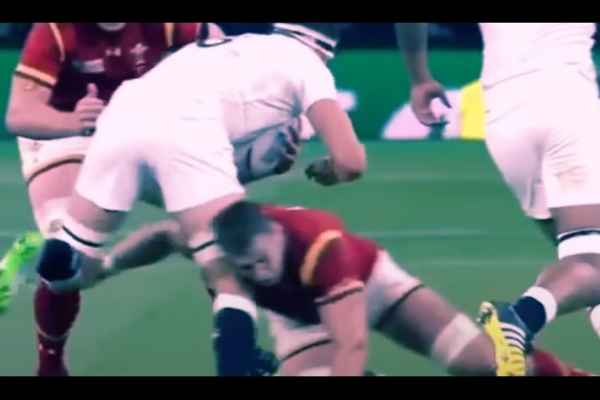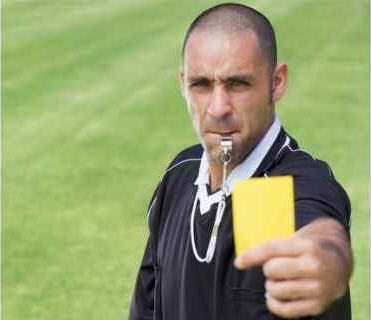Chop tackles became more common in professional and international rugby in the 2010s when Wales used them to good effect.
However, the rugby authorities became concerned that there was an increase in knee injuries to the tackled players.
There was also a debate as to whether the tackling technique was allowed under the current laws. This article explains the full story.
Let’s start by explaining what we’re talking about.
What Is A Chop Tackle?
A chop tackle is when the defender tackles low enough to grasp the ball carrier’s legs below the knee. The aim is to get close to the ankles.
By wrapping their arms around the lower limbs of the ball carrier, the attacker falls forward almost immediately.
The sudden fall is like chopping down a tree. This is how the tackle got its name.
It’s also called a grass-cutter tackle in some regions. The name comes from the body position of the tackles. They dive so low that they are “cutting” the grass.
What Do Chop Tackles Look Like?
The Welsh flanker Dan Lydiate made chop tackles famous in the previous decade.
Here he is at the Rugby World Cup in 2015 at Twickenham.

Chop tackles are not new
It’s not that players haven’t been tackling low since rugby began. But the trend since rugby turned professional was to tackle at a higher level.
Targeting the midriff allows the big hits and has a better chance of preventing the ball carrier from offloading the ball.
Lydiate’s low tackles were so effective because his teammates were in tune with what he was doing. Hunting in pairs, another Welsh player would get over the ball and fight for it.
Because the ball carrier had fallen so quickly and without the chance to place the ball in the best position for his team, Wales won a lot of turnovers.
Notice any problems?
Notice how Lydiate is low enough to make contact beneath the knee of the English hooker (Tony Booth).
His right arm is swinging around to grasp the attacker’s legs.
But did you notice that the tackler’s right hand is already on the ground? You can’t wrap an opponent with one arm.
The England hooker toppled so fast that he flipped over Lydiate. His England teammates weren’t happy with the legality of the tackle and a bit of a ruckus ensued.
The referee deemed the tackle legal.
But things changed the following year. Let’s look now at the area of legalities.
Are Chop Tackles Legal In Rugby?

The laws of rugby often leave a lot of room for interpretation by referees.
There is one relevant line in the laws on foul play:
A player must not charge or knock down an opponent carrying the ball without attempting to grasp that player.
World Rugby laws on foul play
The bolding is mine! The key part is the attempt to “grasp” the opposition player.
Grasping versus wrapping
There are other guidelines on the official World Rugby website that mention using the arms to wrap around the ball carrier.
There’s no doubt that the tackle that we pictured didn’t involve wrapping. The Welsh fans could argue that Lydiate was “attempting” to wrap. Well, maybe that was in his head.
But if you’ve used one hand on the ground to control your tackling motion, you can’t be attempting at the same time to wrap both arms around the opposition.
To be fair to the flanker (who was world-class in his day), grasping is different.
You can grasp with one hand, and nobody is suggesting that a one-handed tap tackle from behind is illegal.
Interpretations have changed

Dan Lydiate made a very similar tackle a year after the World Cup.
In a PRO 12 match in 2016, Lydiate went low to tackle an Edinburgh player. Once again, Lydiate had one hand on the ground. Once again, the ball carrier flips over to the ground.
This time, the referee gave a penalty and a yellow card for a dangerous tackle.
There was plenty of controversy about it at the time. Many fans and pundits pointed out that this was the same tackle that Lydiate had been making for years.
So, what was the difference?
Interestingly, a journalist for Wales Online said that he heard from a referee that World Rugby had told officials to crack down on chop tackles that didn’t have an attempt to wrap.
The reason was due to an increasing number of knee injuries occurring to the tackled players.
So, what’s the final conclusion to the question…
Are chop tackles legal in rugby?
Chop tackles are legal in ruby when the tackler makes a genuine attempt to wrap both arms around the ball carrier.
If the referee judges that there was no attempt to wrap, the tackler will be penalized for dangerous play.
If the referee considers there was a significant chance of injury, the tackler will be given at least a yellow card.
What Other Choices Do Players Have?
Players can’t say that they don’t have other options to bring down ball carriers.
Check out our article on the different types of rugby tackling. There may be more than you think!